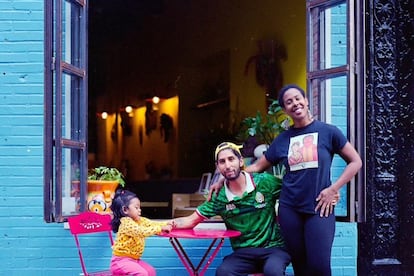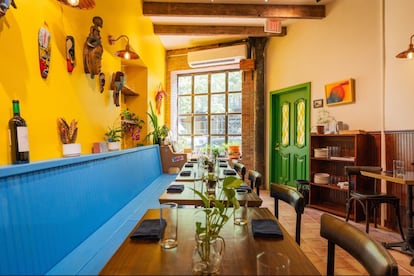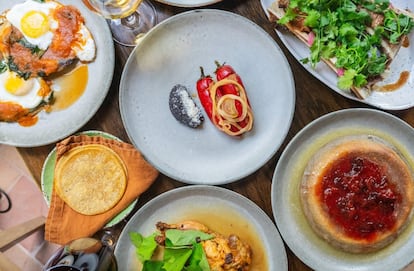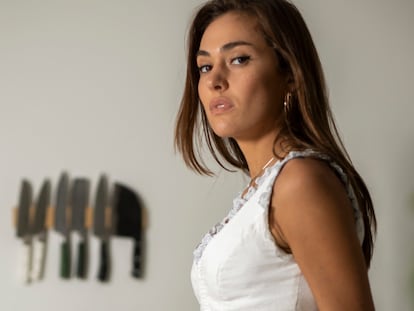Cocina Consuelo, the Mexican restaurant that got started in an apartment during Covid and is now wowing New Yorkers
At the height of the pandemic, Karina García and her husband Lalo Rodríguez hosted dinners in a tiny fifth-floor walk-up. Four years later, they opened a restaurant that rose to best-of-city lists in just four months

It is a house where no one lives. It has a green door, a blue façade and a window facing the street. At the entrance, you are greeted by the smell. It smells like something familiar, because they are the smells of your childhood: stew, corn. The nose sniffs, the eyes search the colors, the yellow of the wall, the hanging masks, the piano, the blue bench, the tables and two visitors focused on their plates. The eye finally finds, standing behind a counter in an open kitchen, a woman whose name is not Consuelo but Karina. Karina García is talking, handling a pan, laughing along with two other women who serve tables.
In August 2024, Cocina Consuelo opened to the public. In just four months, it has positioned itself as one of the best restaurants of the year in New York. Masa pancakes made with corn batter, birria, bone marrow, pumpkin cakes, green chorizos, café de olla, chile relleno, tacos... the entire menu, made in Karina’s style and based on Mexican tradition, has generated very positive reviews in news outlets such as The New Yorker, The New York Post, The Infatuation and Grub Street. It has been such a success that it has also been included on the December list of the Best of 2024.
But Cocina Consuelo wouldn’t exist if it hadn’t already existed four years ago inside a studio apartment. At the height of the Covid pandemic, the Dominican-born chef began to organize dinners with her husband, Lalo Rodríguez, a musician and co-owner of the restaurant. They lived on a fifth-floor walk-up, a space that García describes as “tiny, tiny,” where the kitchen, the living room, and the bedroom were all one. They didn’t have money, they needed it urgently, and they decided to do what they knew how to do: so Karina cooked, and Lalo managed. That first day they invited friends and prepared Lalo’s famous and beloved birria: the Mexican-born Lalo had previously and wisely Mexicanized the palate and interest of his wife, for the good of both of them and, now, also for the good of others.
“And then it turned out that our friends were staying at our place until about two in the morning. And we were there serving them and treating them well… and those friends left and they told others about it. And so the people kept coming. After about three weeks we had to do Friday, Saturday, and Sunday because we were running out of food. Later we did takeout. So we had people who came and picked up the food, and we served others at home. We didn’t know what we were doing,” says Karina.
Food, love, and music at a time of so much loneliness and social abandonment founded the restaurant. At first the restaurant was Karina and Lalo, and for them Cocina Consuelo was literally their home. Sometimes they opened their house and held parties where they didn’t charge a fee. “We gave them food and drinks, there was music… literally the house was open and you came in and out and there were people we didn’t even know.” Years passed, and they realized that Cocina Consuelo needed more space. That place already existed, it was in Hamilton Heights in Manhattan, and it was exactly as they imagined. In it, they managed to recreate the sentimental architecture of their own home, which is above all Mexican.

Question: And what did you prepare at those dinners?
Answer. We started with tacos. People would sit down and have a kind of “omakase” of tacos. Over time, people started ordering more substantial food, and after two years we added more entrees. I remember my husband saying to me, “I understand that you’re doing this, which is very traditional, but why don’t you start experimenting and creating your own dishes?” and I said, “I don’t know…it’s not my food.” It just didn’t come to me to say, OK, I can make this up. He kept insisting until I said, OK, I have to educate myself.
Q. What education did you get?
A. I enrolled in an online school, the School of Mexican Gastronomy in Mexico City. I took a course in Mexican theory, art, and politics. That way I was able to understand how Mexico came to be and how Mexico became the country it is, and therefore its gastronomy. When I understood how that happened and what all the stages it went through were — from pre-Hispanic times to Mesoamerica, then the viceroyalties — I understood a little more about how people eat in Mexico and why they eat the way they do. That way I was able to create things that you may not have eaten, but that taste like something from Mexico.
Q. Had you worked in a Mexican restaurant before?
A. Never. I have never cooked Mexican food professionally, other than this.
Q. Why Mexican food and not, for example, Dominican food?
A. Many of the lessons and the reason why I came to understand the flavors of Mexico is because of my husband Lalo, who is Mexican, right? I have developed my palate very well, to the point that, if you tell me a story about a flavor, I can somehow replicate it. That’s how he taught me to cook the food of his country. I also learned by going to Mexico to cook with grandmothers, aunts, ladies, then I educated myself... I have read many books. However, the Cocina Consuelo project arose very organically, and it was not that we said: “this is what Cocina Consuelo is going to be,” no, it just turned out that way.
Q. And where does the name come from?
A. My husband’s grandmother was named Consuelo. She died in December 2019, just before the pandemic. So we decided to name her after her. And then my mom told me that my paternal grandfather, who I never met, was also named Consuelo. So it was like a wow moment, a divine intervention.
Q. What is the essential ingredient in Mexican cuisine and, particularly, in what you cook?
A. I would say the chiles. The chiles are the backbone of my dishes. I'm glad you asked that because in fact every dish has a chile that dominates the flavor. For example, in the pumpkin pancakes there is the guajillo chile. Without that chile, the pumpkin pancakes wouldn't be what they are. The same with the Bone Marrow, it's the first dish we started Cocina Consuelo with, that's why it's always been on the menu. In that case, it's the chile of the sauce, the chile de árbol.

Q. How do you keep the ingredients so fresh and so true to what they are traditionally?
A. I cook every day or every other day. We like to give the best to our guests, because they are not our clients, they are our guests. So, since this is such a small space, we wanted people to feel comfortable, and to feel more spacious at the tables. So we took on that discomfort in a certain way by reducing the size of the kitchen. We literally have only one refrigerator, and a very small one. That pushes us to cook day by day and at most every other day. That is why when the food arrives, it is fresh. And so in a certain way we continue to honor what it is to eat at home, right? If I have guests, I cook that day for the guests.
Q. That Latin American experience of being in a kitchen with women cooking and eating, how did it come about?
A. It was 100% organic. That was also something that caused us a lot of anxiety before opening. Before, it was just Lalo and me in the house. I mean, we could control everything: the service, the food, the laundry, the cooking, the hosting, right? We were a little afraid of “ok, now we have to give a little bit of control to other people who maybe don’t understand what we want to do here,” but those who work with us understand what we are about. The idea was always to literally transfer the space we have in our house to the business. And what we did was to remain genuine.
Q. And do you feel the need to cook at home for people?
A. Well, in a way, yes. I really liked being able to interact with people, even more than I am doing now. But I feel that the restaurant is so small that I have the opportunity to do it. I can see all the tables and in a way if I can stand at a table and give them a plate, I can do it. So, maybe that, but in another way no, because, as we say, this is the future.
Sign up for our weekly newsletter to get more English-language news coverage from EL PAÍS USA Edition
Tu suscripción se está usando en otro dispositivo
¿Quieres añadir otro usuario a tu suscripción?
Si continúas leyendo en este dispositivo, no se podrá leer en el otro.
FlechaTu suscripción se está usando en otro dispositivo y solo puedes acceder a EL PAÍS desde un dispositivo a la vez.
Si quieres compartir tu cuenta, cambia tu suscripción a la modalidad Premium, así podrás añadir otro usuario. Cada uno accederá con su propia cuenta de email, lo que os permitirá personalizar vuestra experiencia en EL PAÍS.
¿Tienes una suscripción de empresa? Accede aquí para contratar más cuentas.
En el caso de no saber quién está usando tu cuenta, te recomendamos cambiar tu contraseña aquí.
Si decides continuar compartiendo tu cuenta, este mensaje se mostrará en tu dispositivo y en el de la otra persona que está usando tu cuenta de forma indefinida, afectando a tu experiencia de lectura. Puedes consultar aquí los términos y condiciones de la suscripción digital.
More information
Archived In
Últimas noticias
‘Doctor Death’, the journalist who has witnessed 105 executions in Florida
Being trans or gay in a migrant detention center: ‘They call me faggot, queer, bitch’
The metaverse, four years later: Is it finished or just at a standstill?
$3,000 and a plane ticket: The United States increases incentives for migrants to self-deport before the end of the year
Most viewed
- The low-cost creative revolution: How technology is making art accessible to everyone
- Christian Louboutin: ‘Young people don’t want to be like their parents. And if their parents wear sneakers, they’re going to look for something else’
- All the effects of gentrification in one corner of Mexico’s Colonia Roma
- Liset Menéndez de la Prida, neuroscientist: ‘It’s not normal to constantly seek pleasure; it’s important to be bored, to be calm’
- Christmas loses its festive spirit: ICE fears cast shadow over religious celebrations










































